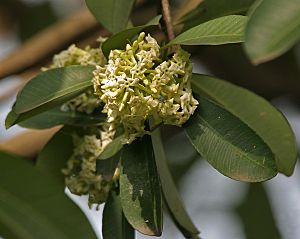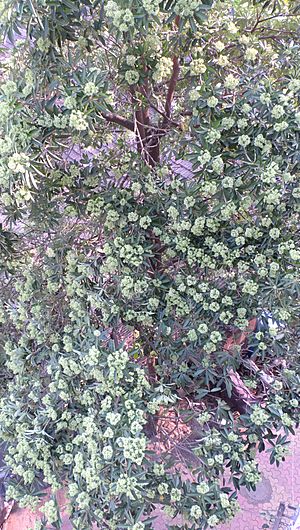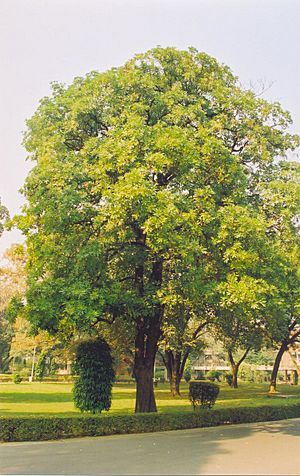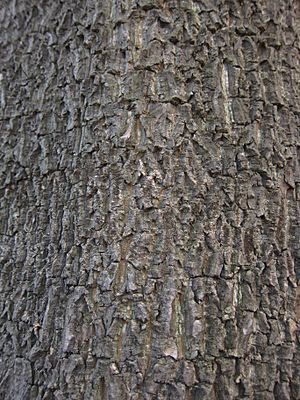Blackboard tree facts for kids
Quick facts for kids Blackboard tree |
|
|---|---|
 |
|
| Blackboard tree (Alstonia scholaris) | |
| Conservation status | |
| Scientific classification | |
| Genus: |
Alstonia
|
| Species: |
scholaris
|
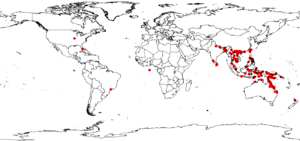 |
|
| Occurrence data from GBIF | |
| Synonyms | |
|
|
Alstonia scholaris, often called the blackboard tree or devil's tree, is a tall, evergreen tree. This means it keeps its leaves all year round. It belongs to the Apocynaceae plant family. You can find this tree naturally growing in southern China, many parts of tropical Asia, and Australasia.
Contents
What Does the Blackboard Tree Look Like?
The Alstonia scholaris is a smooth tree, meaning it has no hairs on its surface. It can grow very tall, sometimes reaching up to 40 meters (about 130 feet) high. Its older bark is usually grayish. The younger branches have many small marks called lenticels, which are like tiny pores.
Leaves, Flowers, and Seeds
The leaves of the blackboard tree are shiny on top and grayish underneath. They grow in groups of three to ten, arranged in a circle around the stem. This arrangement is called a whorl. Each leaf has a short stem, about 1 to 3 centimeters long. The leaves are tough and shaped like a narrow spoon or oval, usually with a rounded tip.
The tree produces many flowers in clusters. These clusters are called cymes. The flowers are white and shaped like a tube, about 6 to 10 millimeters long. Their petals are broad and overlap each other. The flowers bloom in October and have a very strong, sweet smell, much like the night-blooming jasmine.
After the flowers, the tree grows long, thin seed pods called follicles. The seeds inside are oblong and have tiny hairs on their edges, with tufts of hair at each end. The bark of the tree has almost no smell but tastes very bitter. It also contains a lot of milky sap.
Where Does the Blackboard Tree Grow?
The Alstonia scholaris tree is found in many places around the world. It is native to:
- China: In the regions of Guangxi and Yunnan.
- Indian Subcontinent: Including Bangladesh, India, Nepal, Pakistan, and Sri Lanka.
- Southeast Asia: Such as Cambodia, Laos, Indonesia, Malaysia, Myanmar, Papua New Guinea, the Philippines, Thailand, and Vietnam.
- Australia: Specifically in Queensland.
The Alstonia scholaris is also the official state tree of West Bengal in India.
How Is the Blackboard Tree Used?
The blackboard tree has several interesting uses.
Special Traditions and Wood Uses
At Visva-Bharati University in India, there's a special tradition. During graduation ceremonies, leaves from the Alstonia scholaris tree (called Saptaparni) are given to graduates. This tradition was started by the university's founder, Rabindranath Tagore. It connects to the tree's name and its meaning.
The wood of the Alstonia scholaris tree is light and grows quickly. Because of this, it has been suggested for making pencils. In Sri Lanka, its light wood is sometimes used for coffins. In Borneo, the wood near the root is very light and white. People there use it to make things like fishing net floats, kitchen tools, and corks.
In Theravada Buddhism, an ancient form of Buddhism, it is believed that the very first Buddha achieved enlightenment under an Alstonia scholaris tree.
Traditional Medicine Uses
Historically, the bark of the blackboard tree was used in traditional medicine. It was known for its very bitter taste. People in India used it for stomach problems like chronic diarrhea and advanced dysentery. It was also thought to help people feel stronger after fevers or other illnesses that made them weak.
The bark was considered a good remedy for various health issues. It was believed to help with digestion, fight worms, and act as a general tonic. Some old texts describe it as highly valued in the Philippines for its medicinal properties.
What Is Inside the Bark?
The bark of the Alstonia scholaris tree contains special natural chemicals called alkaloids. These include substances like ditamine, echitenine, echitamine, and strictamine. These chemicals are what give the bark its bitter taste and its traditional medicinal properties.
See also
 In Spanish: Alstonia scholaris para niños
In Spanish: Alstonia scholaris para niños



